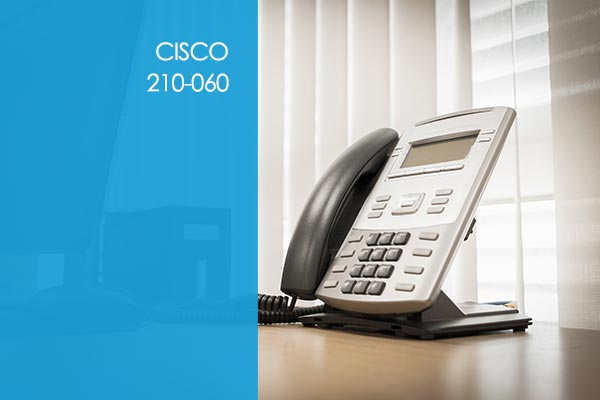Cisco 210-060 CICD: Implementing Cisco Collaboration Devices


About this course
This course focuses on providing the skills and knowledge necessary to implement Cisco Collaboration and UC Solutions. We cover the administration of end-user interfaces, telephony and mobility features, and Cisco UC solutions maintenance.
This course covers several video labs of the day to day administration of a Cisco UC solution and shows candidates step by step procedures to complete the common tasks associated with the day-to-day administration of a Cisco Collaboration solution while preparing for the CICD exam.
- Describe the components of a Cisco Collaboration solution, and identify call flows and signaling types.
- Provide an overview interfaces for both administration and end-users in Cisco Unified Communications Manager, Cisco Unified Communications Manager Express, Cisco Unity Connection, and Cisco Unified Communications Manager IM and Presence Service.
- Understand call flows in Cisco Unified Communications Manager and Cisco Unified Communications Manager Express.
- Perform endpoint and end-user administration tasks in Cisco Unified Communications Manager and Cisco Unified Communications Manager Express
- Describe telephony features supported in CUCM and CUCME
- Administer users in Cisco Unity Connection and Cisco Unified Communications Manager IM and Presence Service, and enable the most commonly used features
- Describe how to maintain a Cisco Collaboration Solution
Course Outline
Module 1 Introducing Cisco Collaboration Architecture
- 1.1 Course Introduction
- 1.2 Introducing Cisco Collaboration Architecture Part 1
- 1.3 Introducing Cisco Collaboration Architecture Part 2
- 1.4 Small To MidSize Business Part 1
- 1.5 Small To MidSize Business Part 2
- 1.6 Small To MidSize Business Part 3
- 1.7 Cisco Unified Communications Manager Part 1
- 1.8 Cisco Unified Communications Manager Part 2
- 1.9 Cisco Unified Communications Manager Part 3
- 1.10 Cisco Unified Connection
- 1.11 Lab Introduction
Module 2 Telephony And Call Routing
- 2.1 Telephony 101 Part 1
- 2.2 Telephony 101 Part 2
- 2.3 Telephony 101 Part 3
- 2.4 Telephony 101 Part 4
- 2.5 Telephony 101 Part 5
- 2.6 Telephony 101 Part 6
- 2.7 Call Routing101Part 1
- 2.8 Call Routing101Part 2
- 2.9 VoIP Call Routing 101
- 2.10 Call Routing With DNS
- 2.11 Deployment Scenarios Part 1
- 2.12 Deployment Scenarios Part 2
- 2.13 Deployment Scenarios Part 3
- 2.14 Gateway Call Routing Basics Part 1
- 2.15 Gateway Call Routing Basics Part 2
- 2.16 Gateway Call Routing Basics Part 3
- 2.17 Gateway Call Routing Basics Part 4
- 2.18 Configuring The Gateway Lab Part 1
- 2.19 Configuring The Gateway Lab Part 2
Module 3 Preparing The Network And Phone Behavior
- 3.1 Preparing The Network For Voices Part 1
- 3.2 Preparing The Network For Voices Part 2
- 3.3 IP Phone Behavior
- 3.4 Configuring The LAN Lab
- 3.5 Standing Up The Platform Lab
- 3.6 Using OVA Templates To Deploy CUCMCUCIMP Lab Part1
- 3.7 Using OVA Templates To Deploy CUCMCUCIMP Lab Part2
- 3.8 Using OVA Templates To Deploy CUCMCUCIMP Lab Part3
- 3.9 Using OVA Templates To Deploy CUCMCUCIMP Lab Part4
- 3.10 Using OVA Templates To Deploy CUCMCUCIMP Lab Part 5
- 3.11 Using OVA Templates To Deploy CUCMCUCIMP Lab Part 6
- 3.12 Using OVA Templates To Deploy CUCMCUCIMP Lab Part 7
- 3.13 Using OVA Templates To Deploy Prime Collaboration Provisioning Lab Part 1
- 3.14 Using OVA Templates To Deploy Prime Collaboration Provisioning Lab Part 2
Module 4 CUCM Administration Interfaces
- 4.1 CUCM Administration Interfaces Part 1
- 4.2 CUCM Administration Interfaces Part 2
- 4.3 CUCM Stand Up
- 4.4 CUCM Stand Up Lab
- 4.5 End User Interfaces
- 4.6 End User Configuration Lab
- 4.7 AD Integration Lab
- 4.8 End Point Implementation Part 1
- 4.9 End Point Implementation Part 2
- 4.10 IMP Integration Lab
- 4.11 CUC Integration Lab Part 1
- 4.12 CUC Integration Lab Part 2
- 4.13 IP Communicator Lab
- 4.14 Profiles And Templates Lab
- 4.15 CUCME Phone Configuration
- 4.16 Configuring CUCME Lab Part 1
- 4.17 Configuring CUCME Lab Part 2
- 4.18 CUCM EndUser Portal Lab
- 4.19 Configuring CUCM Phones From Scratch
- 4.20 Configuring Cisco SX20 Codec Part 1
- 4.21 Configuring Cisco SX20 Codec Part 2
Module 5 Call Configuration
- 5.1 Advanced Call Coverage Part 1
- 5.2 Advanced Call Coverage Part 2
- 5.3 Advanced Call Coverage Part 3
- 5.4 Call Coverage Lab Part 1
- 5.5 Call Coverage Lab Part 2
- 5.6 Call Coverage Lab Part 3
- 5.7 Call Coverage Lab Part 4
- 5.8 Call Coverage Lab Part 5
- 5.9 Calling Constrictions And COS Part 1
- 5.10 Calling Constrictions And COS Part 2
- 5.11 Implementing Class Of Control Lab Part 1
- 5.12 Implementing Class Of Control Lab Part 2
- 5.13 Connecting To The PSTN Part 1
- 5.14 Configuring Voice Gateway Features Lab Part 1
- 5.15 Configuring Voice Gateway Features Lab Part 2
- 5.16 Configuring Voice Gateway Features Lab Part 3
- 5.17 Connecting To The PSTN Part 2
- 5.18 PSTN Calling And Digit Manipulation Lab Part 1
- 5.19 PSTN Calling And Digit Manipulation Lab Part 2
- 5.20 PSTN Dial Plan Configuration Lab Part 1
- 5.21 PSTN Dial Plan Configuration Lab Part 2
- 5.22 Course Conclusion
